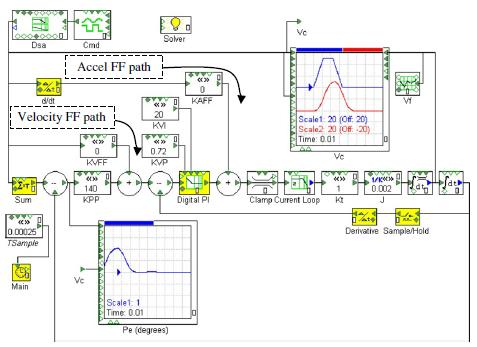Use Experiment 17B to investigate the sensitivity of the P/PI loop concerning changing inertia. a. Tune the
Question:
Use Experiment 17B to investigate the sensitivity of the P/PI loop concerning changing inertia.

a. Tune the system without feed-forward, as in Question 1.
data from question 1
1. Using Experiment 17A, practice tuning by first setting KVP as high as possible with the velocity loop responding to a square wave without overshooting. Retune KVI and KPP as discussed in Section 17.1.2. Be sure to turn “Position Loop” off when tuning or measuring the velocity loop.
a. What are the values of KVP, KVI, and KPP?
b. What is the velocity loop bandwidth?
c. What is the position loop bandwidth?
What is the apparent effect on performance when inertia is reduced from 0.002 kg-m2 to 0.001 kg-m2?
b. Now use the values with velocity and acceleration feed-forward, as in Question 2.
data from question 2
2. Transfer the values from Question 1a into Experiment 17B. Set the feed-forward gains to the maximum values without generating overshoot in response to the default trapezoidal command in the experiment.
a. What are the values of KVF and KAF?
b. What is the position loop bandwidth with feed-forward?
What is the apparent effect on performance when inertia is reduced from 0.002 kg-m2 to 0.001 kg-m2? How much peaking is induced at high frequency?
c. Now use the values with just velocity feed-forward, as in Question 3.
data from question 3
3. Transfer the values from Question 1a into Experiment 17B. Set the velocity feed-forward gain to 0.5 and the acceleration feed-forward gain to zero. Reduce position loop gain to eliminate the overshoot caused by velocity feed-forward.
a. What are the values of KVF and KPP?
b. What is the position loop bandwidth with feed-forward?
What is the apparent effect on performance when inertia is reduced from 0.002 kg-m2 to 0.001 kg-m2?
d What conclusion would you draw?
Step by Step Answer:

Control System Design Guide Using Your Computer To Understand And Diagnose Feedback Controllers
ISBN: 9780123859204
4th Edition
Authors: George Ellis





